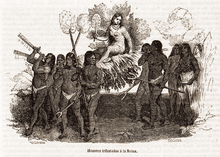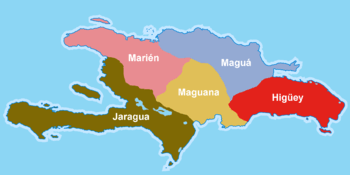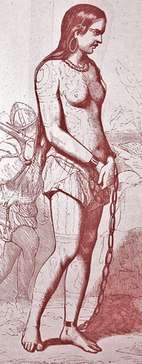Anacaona
Anacaona (1474 (?) –1504) also known as Golden Flower, was a Taíno cacique (chief), religious expert and poet born in Xaragua (Haiti).[1] Before the arrival of Christopher Columbus in 1492, Ayiti, now known as the island of Hispaniola (Haiti and Dominican Republic) was divided into five kingdoms (Xaragua, Maguana, Higuey, Magua and Marien). Anacaona was born into a family of chiefs, and was the sister of Bohecio, the chief of Xaragua.[2]
| Anacaona | |
|---|---|
 Anacaona | |
| Born | 1474 Yaguana, Jaragua, present-day Léogâne, Haiti |
| Died | c. 1504 Hispaniola |
| Spouse | Caonabo |
| Occupation | Cacique |
She succeeded her brother Bohechio as chief of the Xaragua after his death.[3] Under Anacaona's rule, the Spaniard settlers and Xaragua people coexisted and intermarried.
In 1503, during his visit to Xaragua, governor of the island Nicolas Ovando suspected an insurrection among the present Taino chiefs including Anacaona.[3] Ovando gave the order for the chiefs to be captured and burned, and Anacaona was arrested and hanged.[3]
Early Life and Family
Anacaona was born in Yaguana, the capital of Xaragua (present day Léogâne, Haiti)[4] in 1474 (?). Her name was derived from the Taíno words ana, meaning 'flower', and caona, meaning 'gold, golden.'[2] Anacaona's brother Bohechío was a local chieftain and under his rule, Bohecio consolidated power over all territories west of Xaragua in 1475. Through consolidation, to strengthen his political influence, Bohecio married Anacaona to Caonabo, the chieftain of Maguana.[5] Together they had one daughter, Higuemota.
In 1492, Christopher Columbus arrived in the kingdom of Marien (Northern Haiti), in search of a direct route to the Indies (India). Upon arrival, he was greeted by Tainos, who were much smaller in stature compared to the Spanish. Columbus was greeted with gold, corn and other natural resources. In 1493, the Spanish crown established colonies to excavate gold and other minerals. With the establishment of the new colony, the Taino were kidnapped, murdered, raped, and enslaved to satisfy the needs of the Spanish crown.[2]
[5] In 1493, Caonabo was arrested for ordering the destruction of La Navidad (a Spanish colony) and its people.[5] He was shipped to Spain and died in a shipwreck during the journey.[6] When Caonabo was captured, Anacaona returned to Xaragua and served as an advisor to her brother, chief Bohecio.[3]
In 1498, Bohecio was confronted by Bartholomew Columbus, brother of Christopher Columbus (founder of the city of Santo Domingo), who arrived in Xaragua with his troops to subdue Bohecío and extend to his territory and build riches in gold. With his weakened power, Bohechío, advised by Anacaona, decided to recognize the sovereignty of the Catholic Monarchs instead of fight, and commit to pay the tribute with products as cotton, bread, corn, fish and other products.
After Bohecio's death in 1500, Anacoana ruled as cacique until her execution in 1503.[3]


Arrest and death

In the fall of 1503, governor of Nicolas Ovando and his party of 300 traveled on foot to Xaragua.[7] They were received in a lavish ceremony by Anacaona, her nobles, and several Taino chiefs.[7]
While the Taino presented the reception as a welcoming gesture, the Spanish who were present characterized it as an elaborate distraction.[8][6] Ovando's party was under the impression that Anacoana and the present Taino chiefs were planning an insurrection.[6] Ovanda lured the chiefs into a caney (large hut) for a Spanish tournament and gave the signal for the Spaniards to seize and bind the caciques.[7] The caciques were burned in the caney, while other Taino of lower rank were slaughtered outside. Anacaona was arrested and hanged.[3][8]
According to historian Troy S. Floyd, the accounts of these events remain uncertain for many reasons.[8] Even though the separate accounts made it seem as though it was a perfectly segregated fight between the Taino and the Spaniards, the two groups had coexisted and intermarried for six years prior.[8] It is unclear why the Spaniards intermarried with the Taino would let them fall for the trap.[8] Additionally, fifty Spaniards were killed which is a high number of casualties, if the events truly occurred split down ethnic lines.[8] Finally, the Xaragua caciques were respected as some of the most intelligent on the island, and it is unlikely that they could be lured into a hut if they were planning their own revolt.[8][7]
Legacy and influence
Anacaona was also a poet and composer, and is accordingly memorialized in contemporary art and literature across the Caribbean.[9] A statue commemorating her legacy is in Leogane, Haiti (formerly Xaragua). Currently, the tallest building in the Caribbean, Torre Anacaona 27, is named after Cacique Anacaona.[10] The salsa song Anacaona by Cheo Feliciano popularizes her story.[11]
Literature
Music
- "Anacaona" by Ansy and Yole Dérose [14]
- "Anacaona" by Tite Curet Alonso
- "Anacaona" by Irka Mateo's
- "Anacaona" by Cheo Feliciano's [15]
See also
- Chiefdoms of Hispaniola
- Enriquillo
- Anti-Colonialism
- Female Native American leaders
Notes
- Shriver, Cameron (2017). "Native American Almanac: More Than 5,000 Years of the Cultures and Histories of Indigenous People Yvonne Wakim Dennis, Arlene Hirschfelder, and Shannon Rothenberger Flynnby". Great Plains Quarterly. 37 (3): 242–243. doi:10.1353/gpq.2017.0044. ISSN 2333-5092.
- Dictionary of Caribbean and Afro-Latin American biography. Knight, Franklin W.,, Gates, Henry Louis, Jr. Oxford. 2016. ISBN 978-0-19-993580-2. OCLC 952785428.CS1 maint: others (link)
- Las Casas, Bartolome (1552). A Short Account of the Destruction of the Indies.
- Hall, Michael R. (2012). Historical Dictionary of Haiti. Scarecrow Press. p. 158. ISBN 9780810878105.
- Hoeg, Jerry (2015-09-02). "Manuel de Jesús Galván's Enriquillo: A novel look at the environment of marriage in the first colony". Canadian Journal of Latin American and Caribbean Studies. 40 (3): 385–393. doi:10.1080/08263663.2015.1090709. ISSN 0826-3663.
- Las Casas, Bartolome (1552). A Short Account of the Destruction of the Indies.
- Clayton, Lawrence A. Bartolomé de las Casas : a biography. Cambridge. p. 34. ISBN 978-1-139-51846-8. OCLC 796803875.
- Floyd, Troy (1973). The Columbus Dynasty in the Caribbean, 1492-1526. Albuquerque: University of New Mexico Press. pp. 61–63.
- Danticat, Edwidge, 1969- (2005). Anacaona, Golden Flower (1st ed.). New York, NY: Scholastic. ISBN 0-439-49906-2. OCLC 55671862.CS1 maint: multiple names: authors list (link)
- Tallest buildings in the Dominican Republic. Emporis. Accessed 1 February 2020.
- Anacaona: Cheo Feliciano. Lyrics.com Accessed 1 February 2020.
- Danticat, Edwidge, 1969- (2005). Anacaona, Golden Flower. Scholastic. ISBN 0-439-49906-2. OCLC 55671862.CS1 maint: multiple names: authors list (link)
- Roumain, Maryse Noël (August 2012). Anacaona, Ayiti's Taino queen = Anacaona, la reine Taino d'Ayiti. Obina, Donnie,, Fiève, Michèle Jessica. [Montréal]. ISBN 978-1-4669-5199-0. OCLC 853575206.
- Ansy & Yole Derose - Anakaona, retrieved 2019-12-15
- Cheo Feliciano - Anacaona, retrieved 2019-12-15
References
- Bartolomé de las Casas: A Short Account of the Destruction of the Indies.
- Peter Martyr d'Anghiera: De Orbe Novo.
- Samuel M. Wilson: Hispaniola - Caribbean Chiefdoms in the Age of Columbus. The University of Alabama Press, 1990. ISBN 0-8173-0462-2.
Attribution

|title=(help)